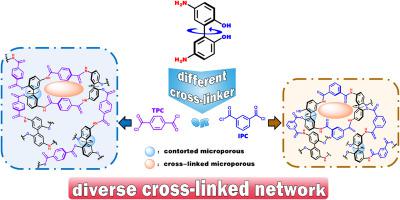当前位置:
X-MOL 学术
›
J. Membr. Sci.
›
论文详情
Our official English website, www.x-mol.net, welcomes your
feedback! (Note: you will need to create a separate account there.)
Construction of ultrathin and microporous polyesteramide nanofilms for efficient organic solvent nanofiltration (OSN) using diacyl chloride
Journal of Membrane Science ( IF 8.4 ) Pub Date : 2024-02-23 , DOI: 10.1016/j.memsci.2024.122605 Mengfan Wang , Shao-Lu Li , Youcai Chen , Qiyu Duan , Dandan Cheng , Genghao Gong , Yunxia Hu
Journal of Membrane Science ( IF 8.4 ) Pub Date : 2024-02-23 , DOI: 10.1016/j.memsci.2024.122605 Mengfan Wang , Shao-Lu Li , Youcai Chen , Qiyu Duan , Dandan Cheng , Genghao Gong , Yunxia Hu

|
The integration of high permeability and exceptional selectivity, thereby overcoming the conventional “trade-off” effect, remains a persistent challenge for the practical implementation of organic solvent nanofiltration (OSN) membranes. Herein, at the molecular level of design, we utilized the 5,5′-diamino-2,2′-biphenol (amino-BIPOL) and diacyl chloride as IP monomers to prepare OSN membranes with high perm-selectivity. The amino-BIPOL, a contorted biphenol molecule with four reactive sites, serves as a molecular-level unit to hinder efficient packing of polymer chains and induce the formation of interconnected micropores in the resulting polyesteramide layers. By employing diacyl chloride terephthaloyl dichloride (TPC) and isophthaloyl dichloride (IPC) as the oil-phase cross-linker, two kinds of TFC membranes were prepared. The resulting membranes both present smooth surface morphology, with ultrathin and high microporous selective layer allowing for efficient mass transfer. Specifically, the methanol permeance of amino-BIPOL/TPC and amino-BIPOL/IPC membrane reaches up to 15.1 and 15.6 LMH/bar, while maintaining a molecular weight cut-off (MWCO) value of 300 and 373 Da, respectively. Overall, this work illustrates the different oil-phase cross-linkers will result in diverse nanofilm microstructure and thus with distinct perm-selectivity properties, offering new insights for the design and modification of advanced OSN membranes.
中文翻译:

使用二酰氯构建超薄微孔聚酯酰胺纳米膜,用于高效有机溶剂纳滤(OSN)
高渗透率和卓越选择性的结合,从而克服传统的“权衡”效应,仍然是有机溶剂纳滤(OSN)膜实际应用的一个持续挑战。在此,在分子水平的设计上,我们利用5,5'-二氨基-2,2'-联苯酚(amino-BIPOL)和二酰氯作为IP单体制备了具有高选择性渗透的OSN膜。氨基-BIPOL是一种具有四个反应位点的扭曲双酚分子,作为分子级单元阻碍聚合物链的有效堆积并诱导在所得聚酯酰胺层中形成互连微孔。以二酰氯对苯二甲酰氯(TPC)和间苯二甲酰氯(IPC)为油相交联剂,制备了两种TFC膜。所得膜均呈现光滑的表面形态,具有超薄且高微孔的选择性层,可实现有效的传质。具体而言,氨基-BIPOL/TPC和氨基-BIPOL/IPC膜的甲醇渗透率分别达到15.1和15.6 LMH/bar,同时保持截留分子量(MWCO)值分别为300和373 Da。总的来说,这项工作说明了不同的油相交联剂将产生不同的纳米膜微观结构,从而具有不同的渗透选择性特性,为先进 OSN 膜的设计和改性提供了新的见解。
更新日期:2024-02-23
中文翻译:

使用二酰氯构建超薄微孔聚酯酰胺纳米膜,用于高效有机溶剂纳滤(OSN)
高渗透率和卓越选择性的结合,从而克服传统的“权衡”效应,仍然是有机溶剂纳滤(OSN)膜实际应用的一个持续挑战。在此,在分子水平的设计上,我们利用5,5'-二氨基-2,2'-联苯酚(amino-BIPOL)和二酰氯作为IP单体制备了具有高选择性渗透的OSN膜。氨基-BIPOL是一种具有四个反应位点的扭曲双酚分子,作为分子级单元阻碍聚合物链的有效堆积并诱导在所得聚酯酰胺层中形成互连微孔。以二酰氯对苯二甲酰氯(TPC)和间苯二甲酰氯(IPC)为油相交联剂,制备了两种TFC膜。所得膜均呈现光滑的表面形态,具有超薄且高微孔的选择性层,可实现有效的传质。具体而言,氨基-BIPOL/TPC和氨基-BIPOL/IPC膜的甲醇渗透率分别达到15.1和15.6 LMH/bar,同时保持截留分子量(MWCO)值分别为300和373 Da。总的来说,这项工作说明了不同的油相交联剂将产生不同的纳米膜微观结构,从而具有不同的渗透选择性特性,为先进 OSN 膜的设计和改性提供了新的见解。





















































 京公网安备 11010802027423号
京公网安备 11010802027423号